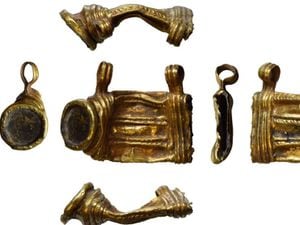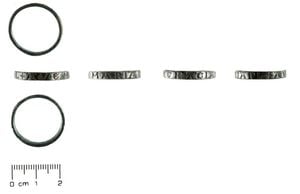Coroner declares historic discoveries found in Shropshire as treasure
They were lost more than 1,000 years apart but two historic finds have been declared treasure by the county's coroner.

The two finds, a late Medieval silver gilt finger ring, and a gold amulet case, are the latest fascinating historic discoveries in Shropshire.
The amulet case dates back to the Roman period, while the finger ring is believed to have dated from 1250 and 1400 AD.
Peter Reavill, finds liaison officer and small finds archaeologist for the British Museum's Portable Antiquities Scheme, said that despite dating from different periods, both items were intended to offer their owners "divine protection".
A treasure inquest heard that the Medieval silver finger ring was found in the Craven Arms area by Mark Davies, who was using a metal detector at the time.
Coroner John Ellery read from a report from the British Museum, which said the ring bears an inscription reading "AVE MARIA GRATIA PL", which translates as "Hail Mary full of grace".
Because it has a precious metal (silver) makeup of at least 10 per cent and is more than 300 years old, it qualified as treasure and Mr Ellery declared it as such.
The Roman gold ring was found near Condover by Laura Wood. It is believed to date to the third or fourth century.
It weighs 7.6g and because of its age and composition of precious metal, it was also declared treasure.
Mr Reavill said that examples from Europe indicate that the Roman amulet could have been intended to offer protection to women giving birth.
A similar piece was previously discovered in Eaton Constantine.

Mr Reavill said: "This highly decorated golden tube is the second such find from the county. Their use is uncertain. Some have been recovered with gold inscribed rolled sheets inside whilst others have other contents.
" All are thought to be good luck charms offering personal protection through magic or religion during the Roman period. Some examples from the continent suggest these charms offer protection during child birth."
Regarding the medieval ring Mr Reavill said that a similar find had been previously made in Shrewsbury.
His report for the coroner said: "The form of this inscribed ‘devotional’ ring is relatively common with several direct parallels and other similar examples reported as potential treasure.
"A gold ring of the same form with an identical inscription was recovered during an emergency excavation in 1984 following the discovery of human remains whilst laying a gas pipe at the Austin Friary in Shrewsbury.
"Several east west aligned inhumation burials were disturbed and subsequently excavated which included a grave of a young lady whose ring was in situ on her finger.
"This ring has been dated to the earlier part of the 15th century.
"Other silver examples with identical inscriptions have been reported as potential treasure and dated to the period 1250-1400 including a silver ring from Shalfleet, Isle of Wight and another from Meldreth, Cambridgeshire."
Speaking after the inquest he added: "The inscription AVE MARIA GRACIA PLENA translates as Hail Mary full of grace. This devotional prayer displayed on the outside of the ring is thought to have been both a display of the wearer's faith as well as bringing the wearer a form of protection."





